Investigation of Sandstone-like Material for Damaged Rock Mass Based on Orthogonal Experimental Method
Abstract
:1. Introduction
2. Experiment Design
2.1. Detection of Deep Rock Composition
2.2. Similarity Criterion
2.3. Orthogonal Test of Rock-like Material
3. Specimen Preparation and Test Process
3.1. Specimen Preparation
3.2. Test Process and Results
4. Results and Discussion
4.1. Analysis of Factors’ Sensitivity to Parameters
4.2. Discussion and Verification Test
4.3. Comparison Test between Sandstone-like Specimen and Sandstone
5. Conclusions
- (1)
- Polystyrene foam was chosen to simulate initial damage in sandstone due to its low strength and ease of deformation. The deformation and strain of sandstone-like materials can be adjusted by the use of different sizes of polystyrene foam, allowing for the characterization of the effect of initial damage on the strength and deformation of the rock mass. The use of polystyrene foam to simulate initial damage can better replicate the random and irregular distribution of damage.
- (2)
- The compressive strength, tensile strength, and elastic modulus of sandstone-like materials are mainly affected by the proportion of binder to aggregate (factor A). The compressive strength and tensile strength increase as factor A increases, while the elastic modulus decreases. Furthermore, the Poisson’s ratio of sandstone-like material is predominantly affected by the proportion of binder to regulator (factor C), and the size of polystyrene foam (factor D) has the most significant impact on the strain. The strain of sandstone-like materials increases as factor D increases, while Poisson’s ratio increases proportionally with the increase in factor C.
- (3)
- The mechanical test conducted on sandstone-like and sandstone specimens indicated that their mechanical parameters and failure modes are highly similar. The elasticity modulus, compressive strength, tensile strength, and Poisson’s ratio of sandstone-like material and sandstone differ by no more than 7%. Both materials undergo three stages of damage: the compaction stage, the elastic deformation stage, and the failure stage. The broken specimens’ surfaces display clear, extended cracks, indicating brittle and destructive characteristics. Sandstone-like materials may be a better alternative to sandstone for mechanical testing, studying the deformation law and failure mode of sandstone, and reducing the difficulty and high cost of obtaining damaged sandstone in large quantities.
Author Contributions
Funding
Data Availability Statement
Conflicts of Interest
References
- Yang, X.; Su, D.L.; Zhou, B.; Liu, Z.; Zhou, C.Y. Experiment study on similarity ratio of similar material for model test on red-bed soft rock. Rock Soil Mech. 2016, 37, 2231–2237. [Google Scholar] [CrossRef]
- Hu, M.; Yang, X.M.; Luo, X.D. Study on mixture ratio scheme of similar materials of red sandstone based on orthogonal experiment. J. Hefei Univ. Technol. (Nat. Sci.) 2020, 43, 736–740. [Google Scholar]
- Gong, Y.F.; Zhu, G.W.; Jiang, Y.P.; Shi, D.J. Experimental study on the proportion of similar materials for different geological structures of coal seams. J. Min. Sci. Technol. 2022, 7, 267–274. [Google Scholar] [CrossRef]
- Zhang, Z.J.; Zhang, Q.Y.; Xiang, W.; Yin, X.J.; Xue, T.E.; Lin, H.X.; Cheng, L.; Guo, X. Development and application of new-style hydro-mechanical coupling similar materials in complex environment. J. Cent. South Univ. (Sci. Technol.) 2021, 52, 4168–4180. [Google Scholar]
- Liu, J.H.; Li, W.X.; Liu, Y.S.; Liu, B.G. A method for determining the ratio of similar material to simulate porous water-bearing stratum. Rock Soil Mech. 2018, 39, 657–664. [Google Scholar] [CrossRef]
- Ning, Y.B.; Tang, H.M.; Zhang, B.C.; Shen, P.W.; Zhang, G.C.; Xia, D. Investigation of the rock similar material proportion based on orthogonal design and its application in base friction physical model tests. Rock Soil Mech. 2020, 41, 2009–2020. [Google Scholar] [CrossRef]
- Dai, S.H.; Wang, H.R.; Han, R.J.; Wang, Z.W. Properties of similar materials used in fluid-solid coupling model test. Rock Soil Mech. 2020, 41, 1–8. [Google Scholar] [CrossRef]
- Wang, P.; Shu, C.; Shi, F.; Hu, G.Z.; Wang, H.T. Orthogonal experimental study of similar materials properties of different densities, sand-binder ratios and residual moisture contents. Rock Soil Mech. 2017, 38, 229–235. [Google Scholar] [CrossRef]
- Li, C.J.; Liu, Y.S.; Li, Y.C.; Zhu, Q.W.; Li, Z.C.; Wang, Z.Y. Experimental study on influencing factors of mechanical properties for mudstone similar material. Saf. Coal Mines 2021, 52, 71–76. [Google Scholar] [CrossRef]
- Liu, Y.L.; Zhou, W.Z.; Guo, B.; Ma, Q.; Xiao, H.L. Study on marl similar materials in similar simulation test. Chin. J. Rock Mech. Eng. 2020, 39, 2795–2803. [Google Scholar] [CrossRef]
- Klammer, A.; Peintner, C.; Gottsbacher, L.; Biermann, J.; Bluemel, M.; Schubert, W.; Marcher, T. Investigation of the Influence of Grain-Scale Heterogeneity on Strainburst Proneness Using Rock-Like Material. Rock Mech. Rock Eng. 2023, 56, 407–425. [Google Scholar] [CrossRef]
- Cao, Y.J.; Shen, W.Q.; Shao, J.F.; Wang, W. A multi-scale model of plasticity and damage for rock-like materials with pores and inclusions. Int. J. Rock Mech. Min. Sci. 2021, 138, 104579. [Google Scholar] [CrossRef]
- Ma, W.B.; Chen, Y.L.; Yi, W.; Guo, S.C. Investigation on crack evolution behaviors and mechanism on rock-like specimen with two circular-holes under compression. Theor. Appl. Fract. Mech. 2022, 118, 103222. [Google Scholar] [CrossRef]
- Zhao, H.Y.; Zhang, L.C.; Wu, Z.H.; Liu, A. Fracture mechanisms of intact rock-like materials under compression. Comput. Geotech. 2022, 148, 104845. [Google Scholar] [CrossRef]
- Zhang, L.; Jing, H.W.; Meng, Y.Y.; Liu, H.X. Experimental Study on the Damage Characteristics and Fracture Behaviour of Rock-like Materials with Weak Interlayer Zones. Ksce J. Civ. Eng. 2022, 26, 4157–4167. [Google Scholar] [CrossRef]
- Ding, W.T.; Huang, X.H.; Wang, Z.R.; Chen, L. Experimental study on the shear performance of a prestressed anchored jointed rock-like mass under different corrosion levels. Int. J. Rock Mech. Min. Sci. 2022, 158, 105209. [Google Scholar] [CrossRef]
- Fan, W.C.; Yang, H.; Jiang, X.L.; Cao, P. Experimental and numerical investigation on crack mechanism of folded flawed rock-like material under uniaxial compression. Eng. Geol. 2021, 291, 106210. [Google Scholar] [CrossRef]
- Hou, G.Y.; Zhou, Y.L.; Zhao, T.L.; Tan, J.X.; Zhao, Q.R.; Huang, J.M. Excavation unloading response of cylindrical rock-like specimen with axial joints: Laboratory experiment and numerical simulation. J. Geophys. Eng. 2023, 20, 21–37. [Google Scholar] [CrossRef]
- Huang, X.P.; Kong, X.Z.; Chen, Z.Y.; Fang, Q. A plastic-damage model for rock-like materials focused on damage mechanisms under high pressure. Comput. Geotech. 2021, 137, 104263. [Google Scholar] [CrossRef]
- Jia, P.; Ji, W.M.; Qian, Y.J.; Zhang, Y.B. Crack Initiation and Propagation of Embedded Three-Dimensional Parallel Cracks in Transparent Rock-Like Material. J. Test. Eval. 2022, 51, 542–557. [Google Scholar] [CrossRef]
- Li, K.S.; Zhao, Z.; Ma, D.P.; Liu, C.X.; Zhang, J.P. Acoustic Emission and Mechanical Characteristics of Rock-Like Material Containing Single Crack Under Uniaxial Compression. Arab. J. Sci. Eng. 2022, 47, 4749–4761. [Google Scholar] [CrossRef]
- Meng, Y.Y.; Jing, H.W.; Sun, S.H.; Chen, M.; Huang, K. Experimental and Numerical Studies on the Anisotropic Mechanical Characteristics of Rock-Like Material with Bedding Planes and Voids. Rock Mech. Rock Eng. 2022, 55, 7171–7189. [Google Scholar] [CrossRef]
- Pan, J.L.; Cai, M.F.; Li, P.; Guo, Q.F. A damage constitutive model of rock-like materials containing a single crack under the action of chemical corrosion and uniaxial compression. J. Cent. South Univ. 2022, 29, 486–498. [Google Scholar] [CrossRef]
- Teng, M.Y.; Bi, J.; Zhao, Y.; Wang, C.L. Experimental study on shear failure modes and acoustic emission characteristics of rock-like materials containing embedded 3D flaw. Theor. Appl. Fract. Mech. 2023, 124, 103750. [Google Scholar] [CrossRef]
- Tian, G.L.; Deng, H.W.; Xiao, Y.G.; Yu, S.T. Experimental Study of Multi-Angle Effects of Micron-Silica Fume on Micro-Pore Structure and Macroscopic Mechanical Properties of Rock-like Material Based on NMR and SEM. Materials 2022, 15, 3388. [Google Scholar] [CrossRef]
- Wang, C.; Li, Y.; Dai, F.; Wu, G.N.; Yin, F.T.; Li, K.P.; Wang, K. Experimental investigation on mechanical properties and failure mechanism of rock-like specimens containing an arc-shaped ice-filled flaw under uniaxial compression. Theor. Appl. Fract. Mech. 2022, 119, 103368. [Google Scholar] [CrossRef]
- Wang, G.Z.; Wang, Y.; Song, L.; Shi, H.; Zhang, M.W.; Yuan, G.T.; Xu, Q.G.; Xu, G.D.; Zhang, W.Q.; Gao, J.J. Particle Flow Simulation of the Strength and Failure Characteristics of a Layered Composite Rock-Like Sample with a Single Hole. Symmetry 2021, 13, 1132. [Google Scholar] [CrossRef]
- Wang, M.; Yu, Z.; Jin, Y.D.; Shao, J.F. Modeling of damage and cracking in heterogeneous rock-like materials by phase-field method. Mech. Res. Commun. 2021, 114, 103612. [Google Scholar] [CrossRef]
- Yu, Z.; Sun, Y.; Vu, M.N.; Shao, J.F. Modeling of Mixed Cracks in Rock-Like Brittle Materials Under Compressive Stresses by a Double-Phase-Field Method. Rock Mech. Rock Eng. 2022, 56, 2779–2792. [Google Scholar] [CrossRef]
- Zhao, H.Y.; Zhang, L.C.; Wu, Z.H.; Liu, A. A new discrete element model for rock-like materials. Comput. Struct. 2022, 261–262, 106730. [Google Scholar] [CrossRef]
- Deng, H.; Tian, G.; Yu, S.; Jiang, Z.; Zhong, Z.; Zhang, Y. Research on Strength Prediction Model of Sandstone-like Material Based on Nuclear Magnetic Resonance and Fractal Theory. Appl. Sci. 2020, 10, 6601. [Google Scholar] [CrossRef]
- Gao, P.; Wang, M.; Lei, X.; Zong, Q. Dynamic Mechanics and Crystal Structure Fracture Characteristics of Rock-like Materials in Coal Mines. Minerals 2022, 12, 290. [Google Scholar] [CrossRef]
- Tian, J.L.; Wang, L.Q.; An, C.L.; Wu, Q.; Sun, Z.H.; Ke, R. Development of a Model Material for Dynamic Geotechnical Model Tests. Appl. Sci. 2022, 12, 5344. [Google Scholar] [CrossRef]
- Wang, J.X.; Cao, A.S.; Liu, J.X.; Wang, H.R.; Liu, X.T.; Li, H.B.Q.; Sun, Y.W.; Long, Y.X.; Wu, F. Numerical Simulation of Rock Mass Structure Effect on Tunnel Smooth Blasting Quality: A Case Study. Appl. Sci. 2021, 11, 10761. [Google Scholar] [CrossRef]
- GB/T 50266-2013; Ministry of Electric Power Industry of The People’s Republic of China. Standard for the Test Methods of Engineering Rock Mass. China Planning Press: Beijing, China, 2013.
- Cui, Y.; Xu, C.; Xue, L.; Dong, J.Y.; Jiang, T. Experimental study on the reasonable proportions of rock-like materials for water-induced strength degradation in rock slope model test. Sci. Rep. 2023, 13, 9288. [Google Scholar] [CrossRef]
- Yang, X.L.; Dong, J.Y.; Yang, J.H.; Han, X.D. Similar Material Proportioning Tests and Mechanical Properties Based on Orthogonal Design. Materials 2023, 16, 6439. [Google Scholar] [CrossRef]
- Yang, M.Z.; Yang, Y.; Zhao, B. Study on the Proportion of Conglomerate Similar Materials Based on the Orthogonal Test. Shock Vib. 2021, 2021, 6657323. [Google Scholar] [CrossRef]
- Huang, X.; Shi, C.; Ruan, H.N.; Zhang, Y.P.; Zhao, W. Stable Crack Propagation Model of Rock Based on Crack Strain. Energies 2022, 15, 1885. [Google Scholar] [CrossRef]
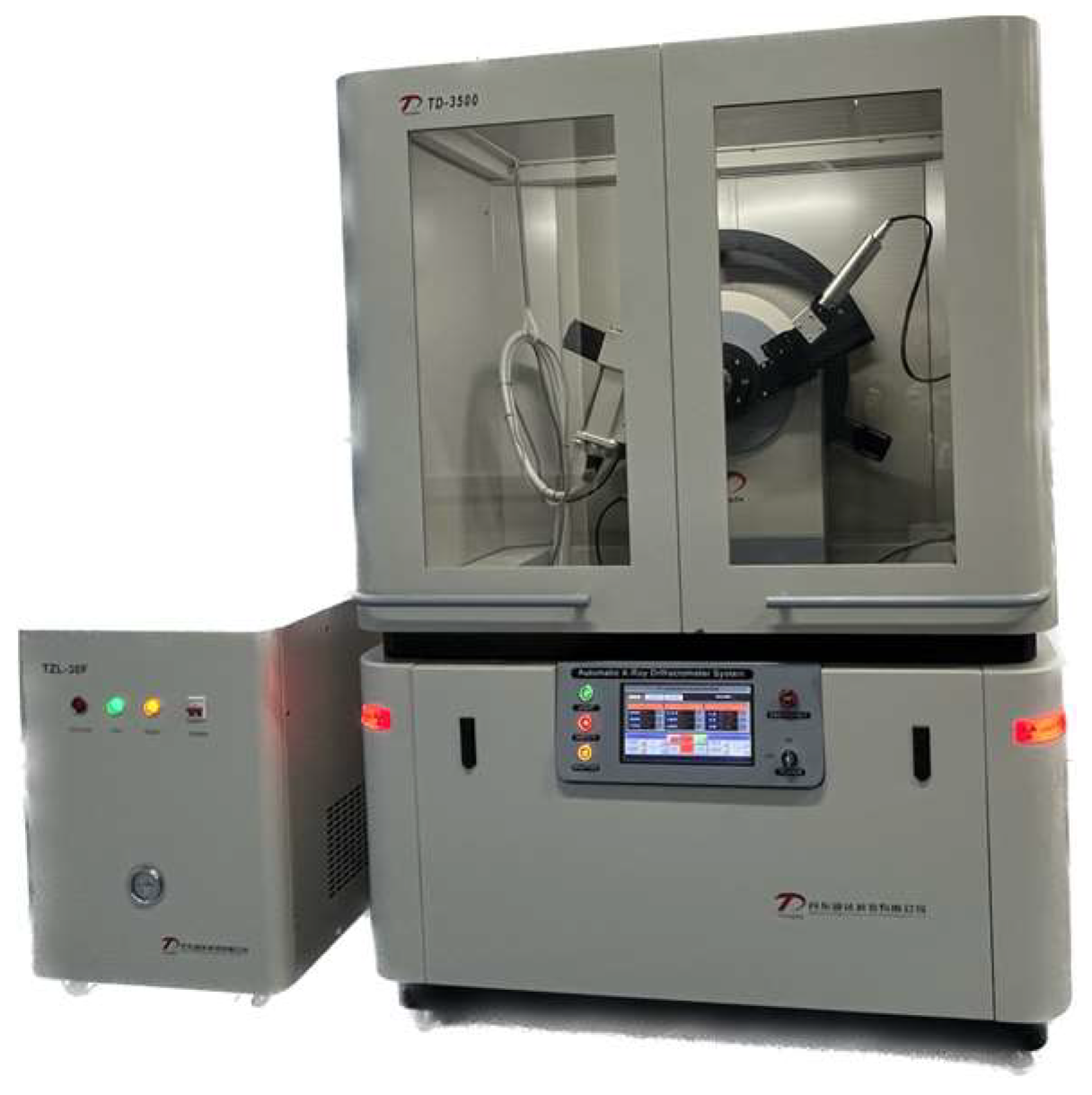
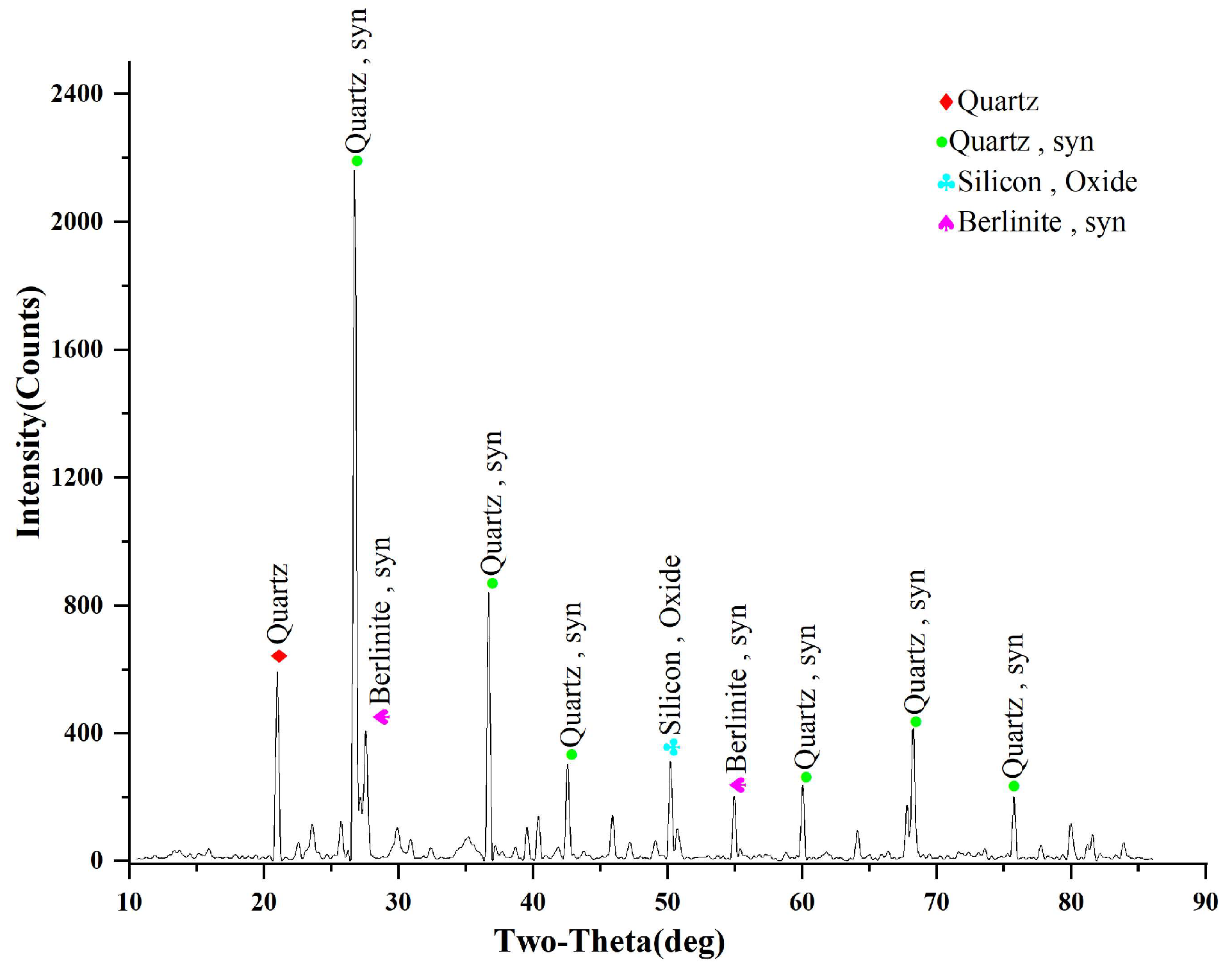
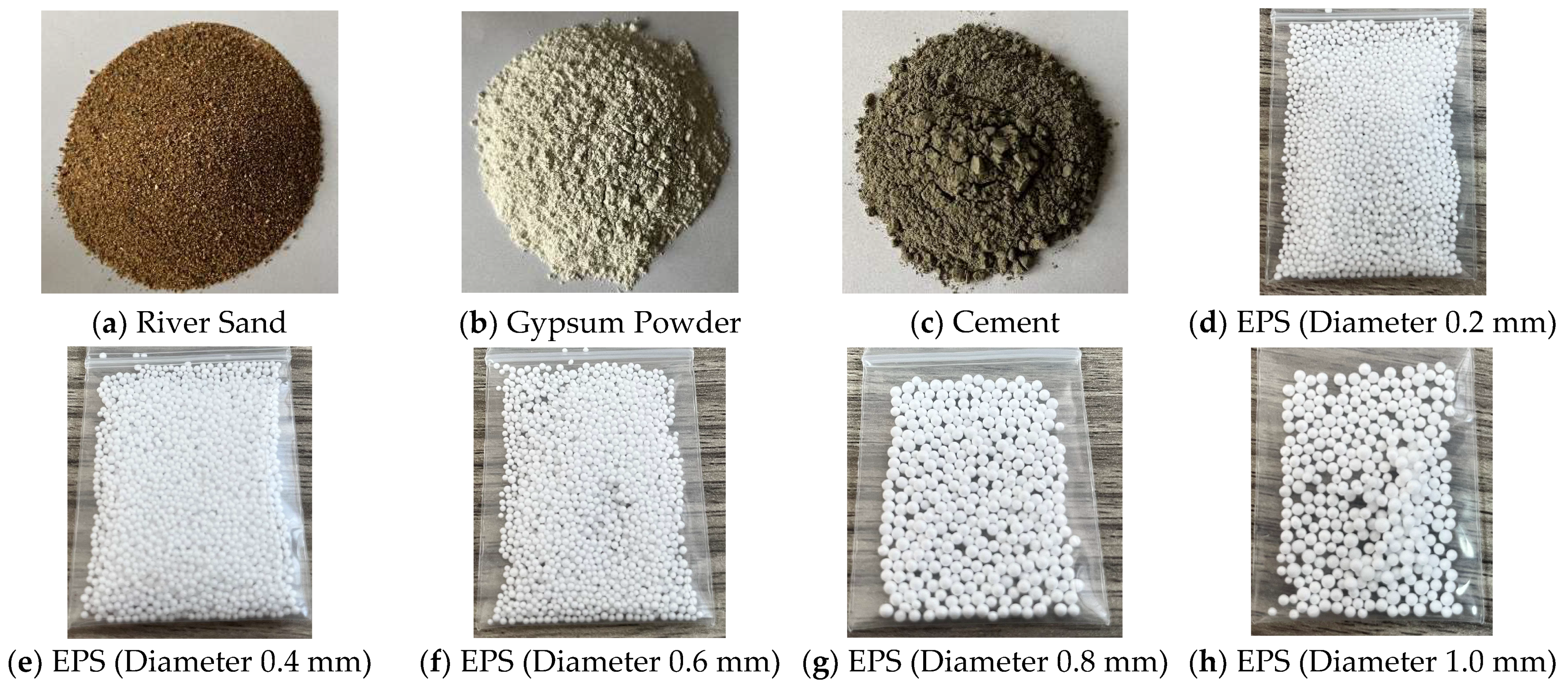
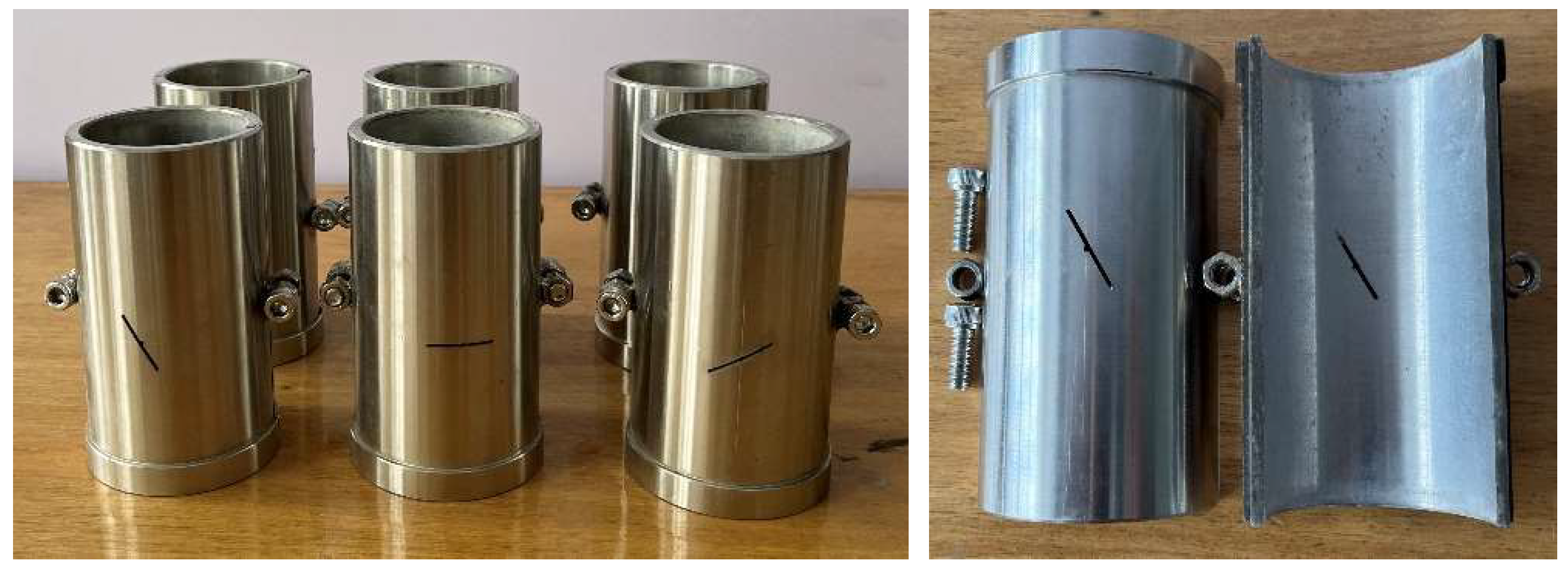
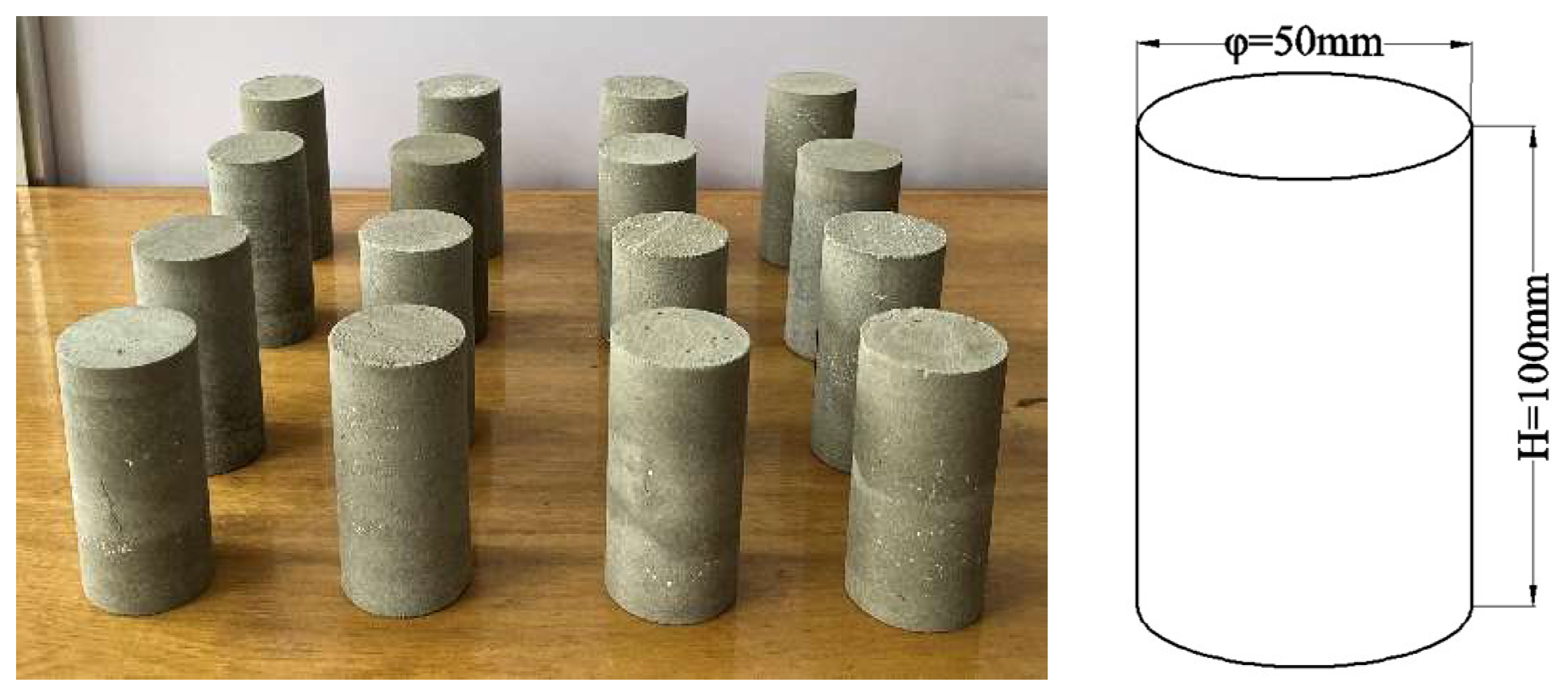




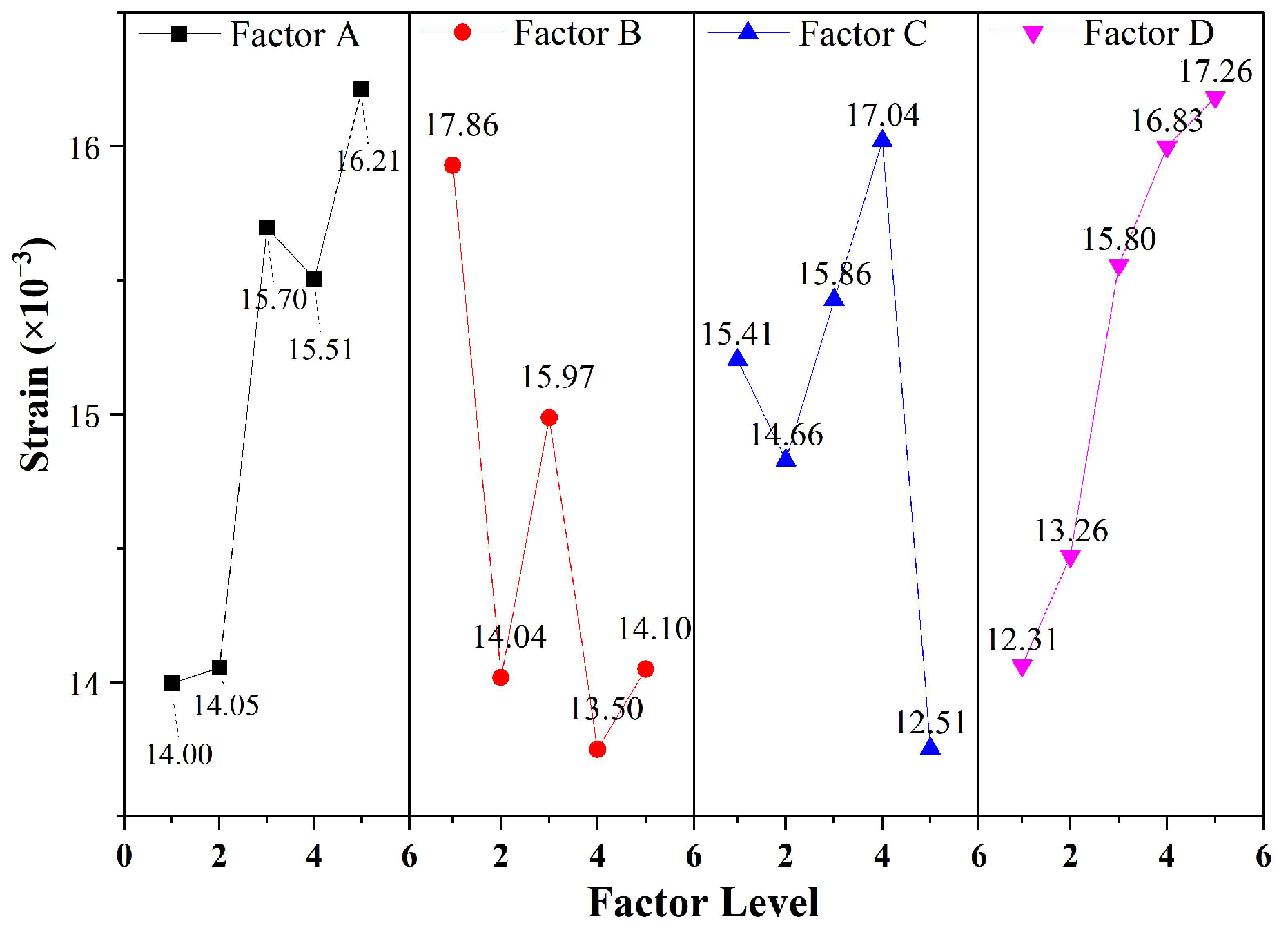
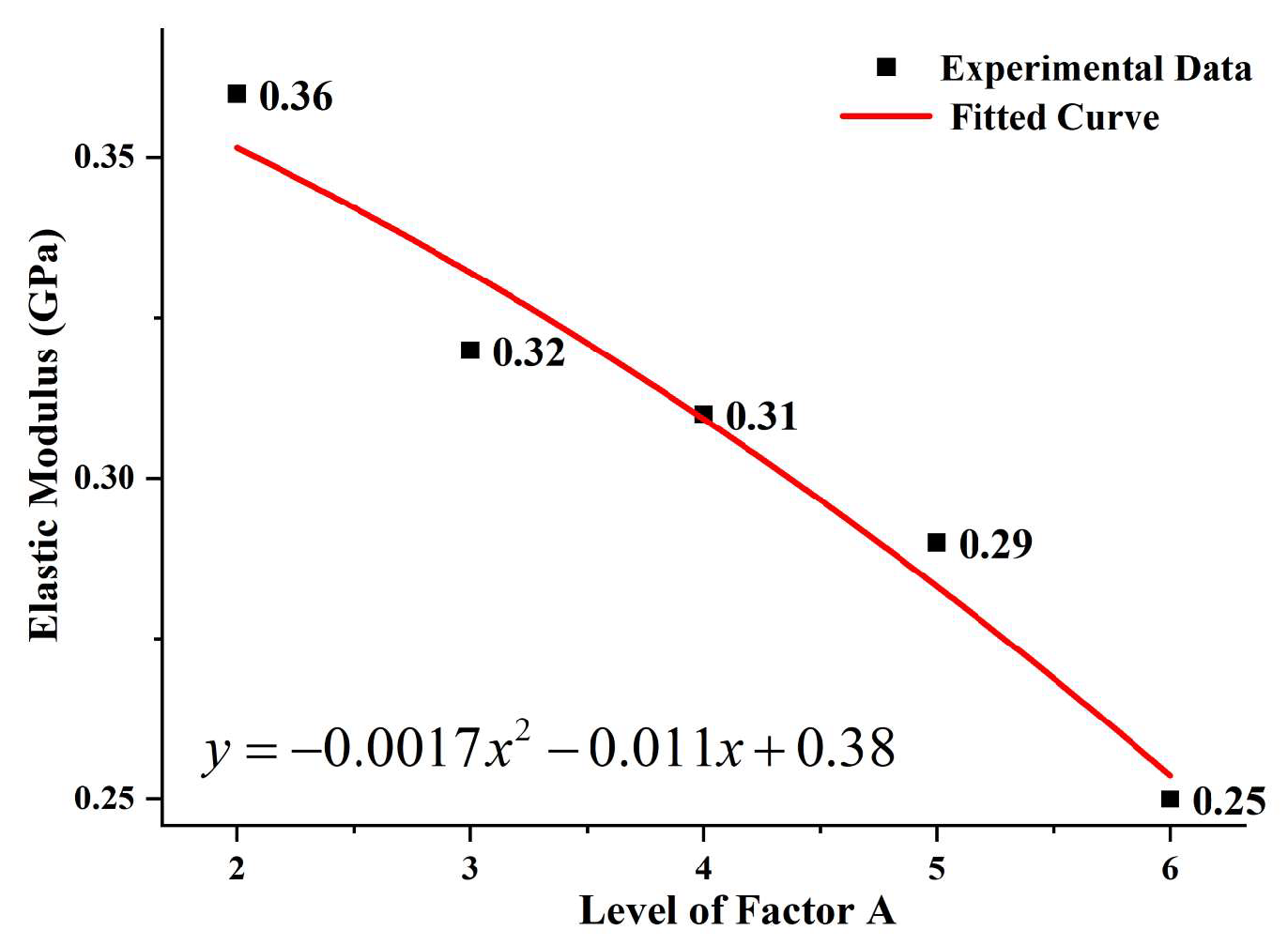
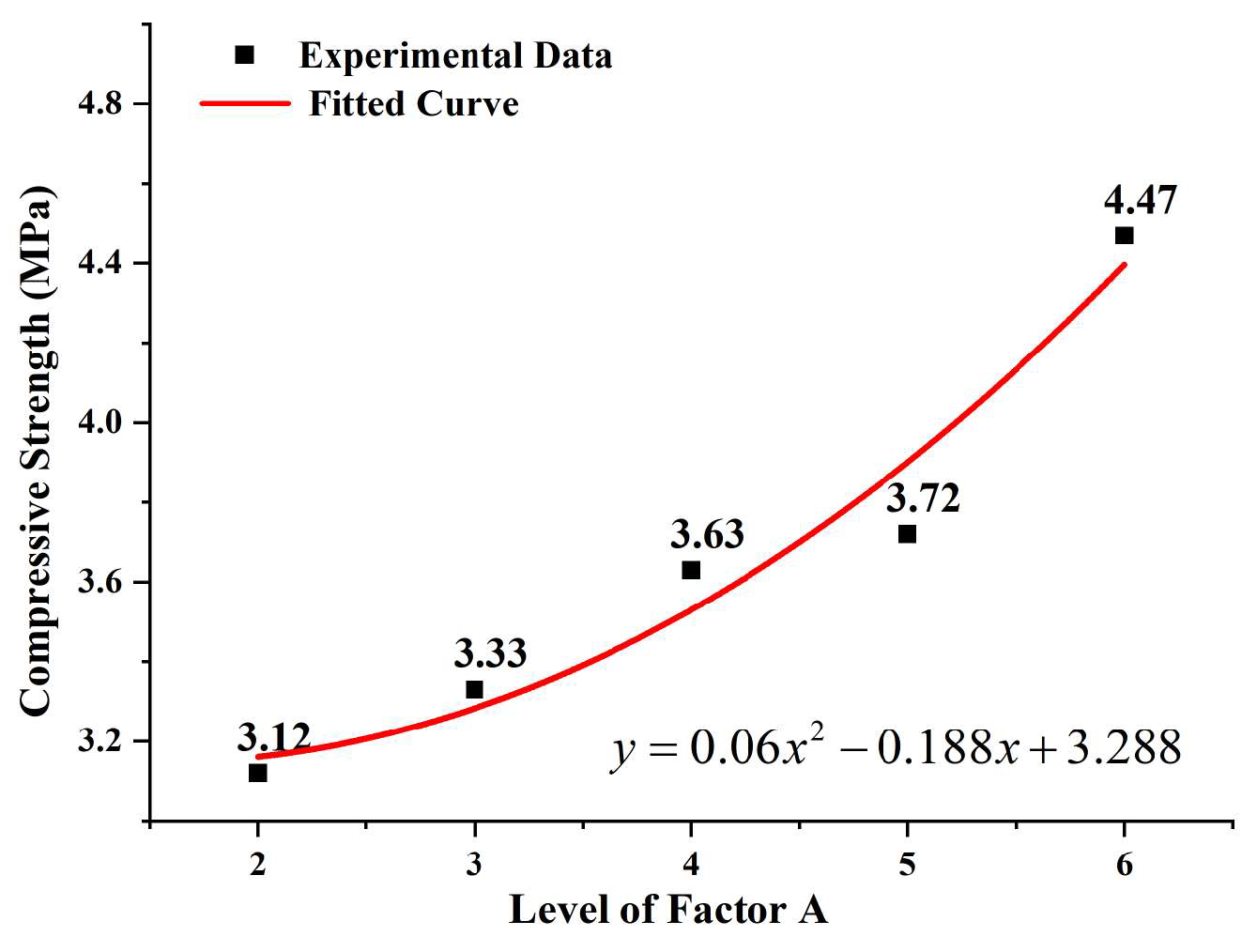
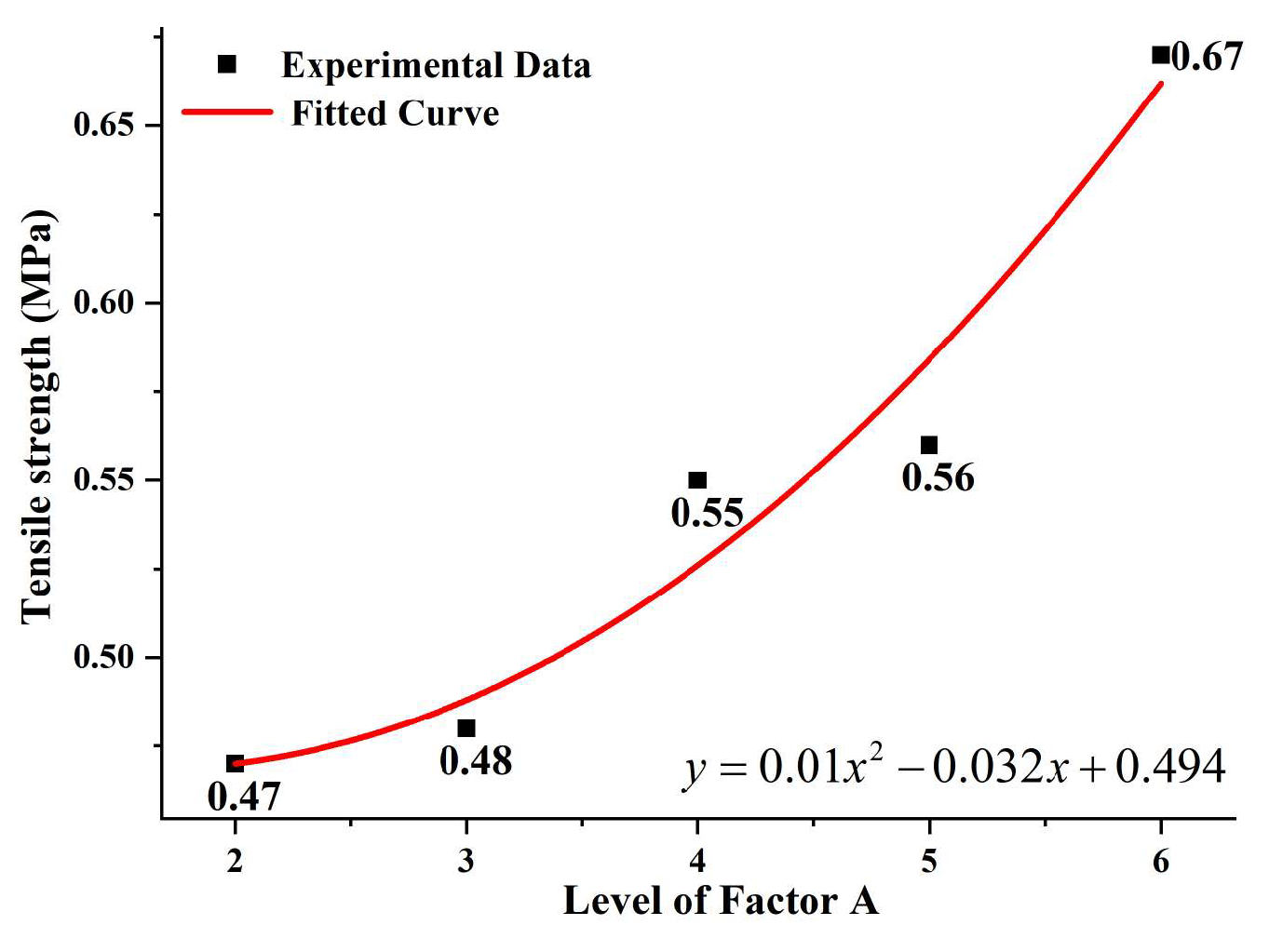


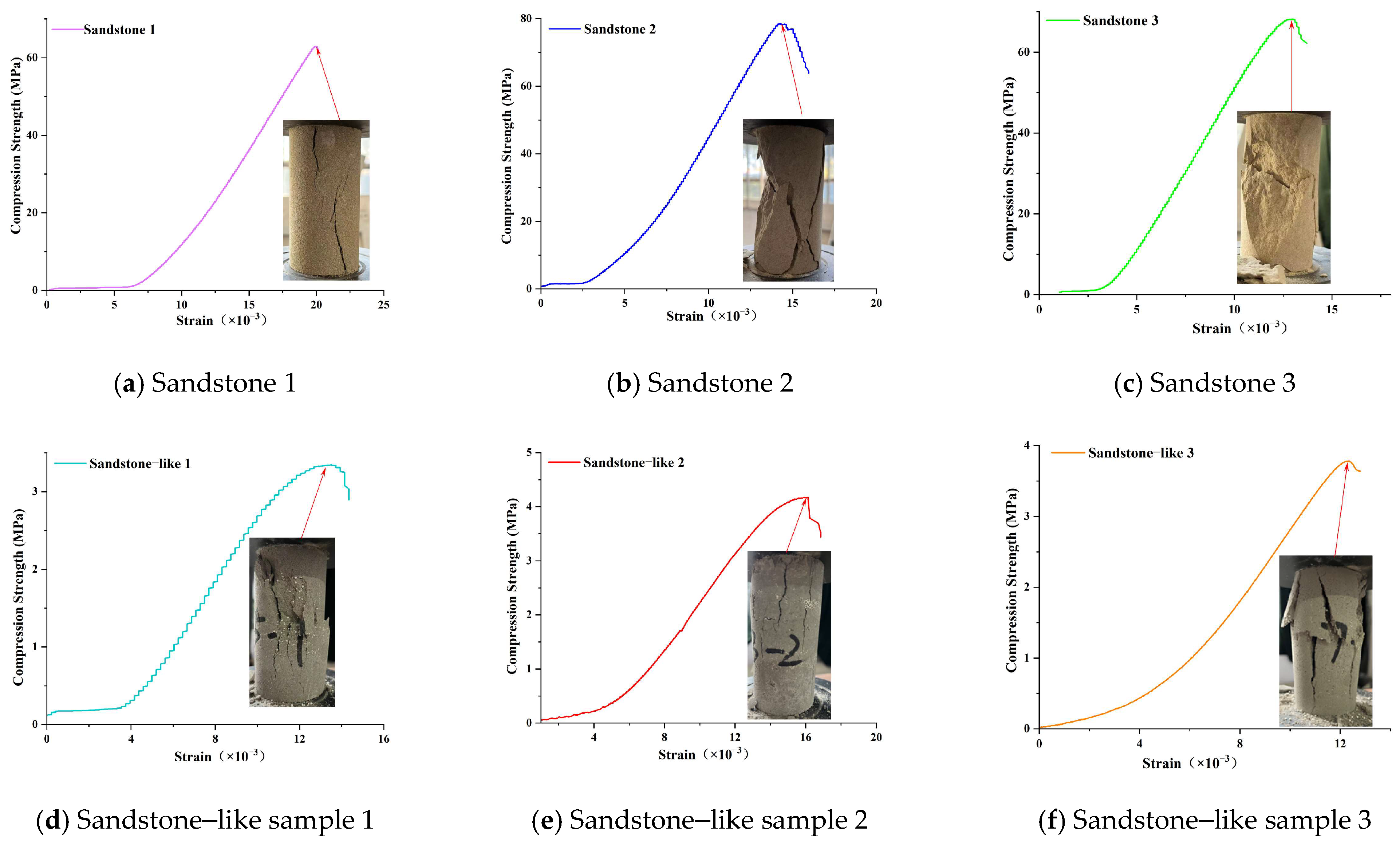
| Index | Diffraction Radius | Scanned Range of 2θ | Scanning Speed | Repeated Accuracy of 2θ | Minimum Step Angle | Accuracy of Measurement |
|---|---|---|---|---|---|---|
| Performance Parameter | 185 mm | −35~170° | 0.006~120°/min | ≤0.0005° | 0.0001° | ≤0.001° |
| Level | Factor A | Factor B | Factor C | Factor D |
|---|---|---|---|---|
| % | % | mm | ||
| 1 | 2:1 | 1.0 | 25 | 0.2 |
| 2 | 3:1 | 1.5 | 30 | 0.4 |
| 3 | 4:1 | 2.0 | 35 | 0.6 |
| 4 | 5:1 | 2.5 | 40 | 0.8 |
| 5 | 6:1 | 3.0 | 45 | 1.0 |
| Number | Factor | |||
|---|---|---|---|---|
| A | B (%) | C (%) | D (mm) | |
| 1 | 3:1 | 1.5 | 40 | 0.4 |
| 2 | 6:1 | 1.0 | 30 | 0.4 |
| 3 | 5:1 | 1.0 | 35 | 0.6 |
| 4 | 2:1 | 1.5 | 45 | 0.6 |
| 5 | 4:1 | 1.0 | 40 | 0.8 |
| 6 | 3:1 | 2.0 | 35 | 0.8 |
| 7 | 5:1 | 1.5 | 30 | 1.0 |
| 8 | 6:1 | 1.5 | 25 | 0.8 |
| 9 | 6:1 | 2.5 | 40 | 0.6 |
| 10 | 5:1 | 2.5 | 45 | 0.8 |
| 11 | 4:1 | 2.5 | 25 | 1.0 |
| 12 | 3:1 | 2.5 | 30 | 0.2 |
| 13 | 3:1 | 1.0 | 45 | 1.0 |
| 14 | 5:1 | 2.0 | 25 | 0.4 |
| 15 | 2:1 | 2.0 | 40 | 1.0 |
| 16 | 2:1 | 1.0 | 25 | 0.2 |
| 17 | 4:1 | 1.5 | 35 | 0.2 |
| 18 | 6:1 | 3.0 | 35 | 1.0 |
| 19 | 2:1 | 2.5 | 35 | 0.4 |
| 20 | 4:1 | 3.0 | 45 | 0.4 |
| 21 | 3:1 | 3.0 | 25 | 0.6 |
| 22 | 5:1 | 3.0 | 40 | 0.2 |
| 23 | 6:1 | 2.0 | 45 | 0.2 |
| 24 | 2:1 | 3.0 | 30 | 0.8 |
| 25 | 4:1 | 2.0 | 30 | 0.6 |
| Number | Compress Strength (MPa) | Tensile Strength (MPa) | Elastic Modulus (GPa) | Axial Strain (×10−3) | Poisson’s Ratio |
|---|---|---|---|---|---|
| 1 | 2.43 | 0.39 | 0.24 | 14.97 | 0.29 |
| 2 | 2.93 | 0.52 | 0.13 | 19.19 | 0.19 |
| 3 | 3.12 | 0.54 | 0.22 | 23.78 | 0.26 |
| 4 | 2.22 | 0.45 | 0.29 | 10.81 | 0.33 |
| 5 | 3.80 | 0.55 | 0.25 | 18.63 | 0.26 |
| 6 | 2.22 | 0.42 | 0.24 | 19.51 | 0.19 |
| 7 | 4.34 | 0.62 | 0.24 | 14.99 | 0.34 |
| 8 | 7.75 | 0.85 | 0.34 | 18.01 | 0.19 |
| 9 | 4.31 | 0.60 | 0.21 | 15.64 | 0.31 |
| 10 | 3.86 | 0.55 | 0.33 | 11.73 | 0.36 |
| 11 | 4.17 | 0.52 | 0.34 | 22.26 | 0.21 |
| 12 | 3.92 | 0.54 | 0.43 | 7.37 | 0.29 |
| 13 | 5.20 | 0.64 | 0.37 | 15.13 | 0.22 |
| 14 | 3.05 | 0.49 | 0.36 | 10.92 | 0.27 |
| 15 | 3.93 | 0.54 | 0.41 | 19.84 | 0.38 |
| 16 | 2.80 | 0.45 | 0.38 | 12.56 | 0.27 |
| 17 | 3.39 | 0.65 | 0.34 | 11.39 | 0.26 |
| 18 | 2.42 | 0.66 | 0.29 | 14.09 | 0.33 |
| 19 | 2.97 | 0.43 | 0.35 | 10.51 | 0.34 |
| 20 | 3.53 | 0.56 | 0.32 | 10.73 | 0.36 |
| 21 | 2.90 | 0.40 | 0.32 | 13.29 | 0.21 |
| 22 | 4.25 | 0.59 | 0.33 | 16.12 | 0.27 |
| 23 | 4.93 | 0.71 | 0.27 | 14.14 | 0.35 |
| 24 | 3.66 | 0.50 | 0.36 | 16.27 | 0.27 |
| 25 | 3.24 | 0.47 | 0.29 | 15.47 | 0.23 |
| Factor Level | Elastic Modulus (GPa) | |||
|---|---|---|---|---|
| Factor A | Factor B | Factor C | Factor D | |
| 1 | 0.36 | 0.27 | 0.35 | 0.35 |
| 2 | 0.32 | 0.29 | 0.29 | 0.28 |
| 3 | 0.31 | 0.31 | 0.29 | 0.27 |
| 4 | 0.29 | 0.33 | 0.29 | 0.30 |
| 5 | 0.25 | 0.32 | 0.32 | 0.33 |
| Range | 0.11 | 0.06 | 0.06 | 0.08 |
| Mechanical Parameter | Equation | R2 |
|---|---|---|
| Elastic Modulus | y = −0.0017x2 − 0.011x + 0.38 | 0.95184 |
| Compressive Strength | y = 0.06x2 − 0.188x + 3.288 | 0.90189 |
| Tensile Strength | y = 0.01x2 − 0.032x + 0.494 | 0.90047 |
| Poisson Ratio | y = −2.857 × 10−5x2 + 0.007x + 0.087 | 0.97146 |
| Strain | y = −4.54x2 + 12.179x + 9.783 | 0.92684 |
| Parameters | Compressive Strength (MPa) | Tensile Strength (MPa) | Elasticity Modulus (GPa) | Poisson’s Ratio |
|---|---|---|---|---|
| Sandstone 1 | 62.91 | 11.25 | 5.24 | 0.25 |
| Similarity parameter * 1 | 3.16 | 0.56 | 0.31 | 0.25 |
| Sandstone 2 | 78.53 | 10.12 | 6.85 | 0.32 |
| Similarity parameter * 2 | 3.93 | 0.51 | 0.34 | 0.32 |
| Sandstone 3 | 68.21 | 12.5 | 6.91 | 0.27 |
| Similarity parameter * 3 | 3.41 | 0.63 | 0.35 | 0.27 |
| Sandstone-like 1 | 3.36 | 0.53 | 0.29 | 0.24 |
| Sandstone-like 2 | 4.17 | 0.49 | 0.33 | 0.31 |
| Sandstone-like 3 | 3.64 | 0.66 | 0.36 | 0.26 |
Disclaimer/Publisher’s Note: The statements, opinions and data contained in all publications are solely those of the individual author(s) and contributor(s) and not of MDPI and/or the editor(s). MDPI and/or the editor(s) disclaim responsibility for any injury to people or property resulting from any ideas, methods, instructions or products referred to in the content. |
© 2024 by the authors. Licensee MDPI, Basel, Switzerland. This article is an open access article distributed under the terms and conditions of the Creative Commons Attribution (CC BY) license (https://creativecommons.org/licenses/by/4.0/).
Share and Cite
Wang, H.; Xie, F.; Song, J.; Bao, W.; Yin, Z.; Fu, X.; Tian, Y. Investigation of Sandstone-like Material for Damaged Rock Mass Based on Orthogonal Experimental Method. Buildings 2024, 14, 686. https://doi.org/10.3390/buildings14030686
Wang H, Xie F, Song J, Bao W, Yin Z, Fu X, Tian Y. Investigation of Sandstone-like Material for Damaged Rock Mass Based on Orthogonal Experimental Method. Buildings. 2024; 14(3):686. https://doi.org/10.3390/buildings14030686
Chicago/Turabian StyleWang, Hongwei, Fuxiang Xie, Jian Song, Wenke Bao, Zhaoming Yin, Xi Fu, and Yong Tian. 2024. "Investigation of Sandstone-like Material for Damaged Rock Mass Based on Orthogonal Experimental Method" Buildings 14, no. 3: 686. https://doi.org/10.3390/buildings14030686







